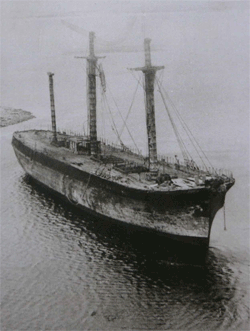SS Great Britain
Delivering the goods
Some vessels made important contributions to the war effort long after their sailing days were over. One such was the SS GREAT BRITAIN. She had been launched in July 1843 and, after an interesting career, she found herself at Port Stanley in the Falkland Islands where a fire on board had damaged her beyond economic career. She was sold to the Falkland Islands Company and used, afloat, as a storage hulk (for coal and later wool) until 1937. It was in this role at 70 years old that she was destined to play an important part in the Battle of the Falkland Islands in December 1914.

At the end of October 1914, the German East Asiatic Cruiser Squadron under the command of Vice-Admiral Graf von Spee was on surface raider duties around the coast of South America. The squadron consisted of two powerful armoured cruisers, the SCHARNHORST and the GNEISENAU, and three lighters cruisers, the EMDEN, NURNBERG and LEIPZIG. On 27 October 1914, the German fleet put into Valparaiso on the west coast of Chile for coal. The Admiralty then sent a squadron under Rear Admiral Sir Christopher Cradock to hunt them down, and his ships were coaled from SS GREAT BRITAIN moored at the Falkland Islands.
Von Spee had been monitoring the squadron’s movements and headed towards the Chilean port of Coronel. On 1 November 1914 Cradock spotted Spee’s better armed squadron off the coast and decided to engage the enemy vessels. In the Battle of Coronel, which lasted less than an hour, two British armoured cruisers, HMS GOOD HOPE and HMS MONMOUTH, were sunk. The armed liner OTRANTO, along with the light cruiser HMS GLASGOW and an old battleship CANOPUS, retreated to the Falkland Islands.
The Admiralty gave orders to chase down von Spee, and a squadron under Vice Admiral Sturdee with two battle cruisers, HMS INVINSIBLE and HMS INFLEXIBLE was despatched to the South Atlantic. On 26 November 1914 they rendezvoused with the South American squadron under the command of Rear Admiral Archibald Stoddart in HMS DEFENCE, accompanied by HMS BRISTOL, HMS CAERNARVON, HMS CORNWALL and HMS KENT, together with HMS GLASGOW and nine colliers.
All the vessels were steam-powered and required enormous quantities of coal to operate. The vast hulk of the SS GREAT BRITAIN, afloat at Port Stanley in the Falkland Islands, acted as the principal means of re-coaling the Royal Navy’s South Atlantic fleet. Sturdee’s squadron arrived off Stanley on 7 December, and all except the battle cruisers began coaling, in either Port Stanley or Port William, a large anchorage immediately north of Stanley.
After his success at Coronel Spee decided to head home, but heard that the Falkland Islands were lightly defended, so he proposed to call in to destroy the port facilities and wireless station. He was unaware of the arrival of the British battle fleet. At 7.55 am on 8 December a four-funnelled warship was spotted on the horizon by lookouts at Sappers Hill, who telephoned the news to Port Stanley.
At 9 am two ships, which had been sent to reconnoitre, GNEISENAU and NURNBERG, came close to Port William where the ships were coaling. Sturdee’s flagship HMS Invincible was coaling alongside SS GREAT BRITAIN, a process that took two hours to complete. The German vessels first noted the tall masts of the wireless station, followed by a column of smoke, which rose, from the middle of the harbour. They assumed at first that this was the British firing the coal stocks on board SS GREAT BRITAIN, before spotting the tripod masts of two battle cruisers.
CANOPUS, beached on a mud bank as a guard ship, opened fire. Sturdee ordered a chase and the British fleet set off in pursuit. In addition to GNEISENAU and NURNBERG three other German warships were spotted, SCHARNHORST, LEIPZIG and DRESDEN. In the Battle of the Falkland Islands that followed SCHARNHORST, GNEISENAU, NURNBERG and LEIPZIG were all sunk. DRESDEN and KONINGSBERG escaped but were later caught and sunk.
Throughout the Battle, the great hulk of the SS GREAT BRITAIN lay at anchor within earshot of the gunfire that destroyed von Spee’s fleet. She subsequently became an object of great affection. Officers from the British Fleet visited her after the battle and she became a place of pilgrimage to seafarers and others throughout her life as a coal and later as a wool hulk. She was also seen as an important public monument by the Falkland islanders themselves.
Where is she now?
SS GREAT BRITAIN continued in her role as a hulk until 1937. On April 14 1937, she was towed a few miles out of Port Stanley to shallow water in Sparrow Cove; holes were punched in her bottom and she settled on the seabed. In the Second World War, some of her iron was scavenged to repair HMS EXETER, one of the Royal Navy ships that fought the GRAF SPEE and was badly damaged during the Battle of the River. She remained at Sparrow Cove until 1970. In April 1970, she was re-floated, returning to her original dock Bristol in July that year where she underwent a major conservation programme.
The ship has been very carefully and sympathetically adapted to meet modern museum standards of visitor access. She is now a major visitor attraction in Bristol Harbour.
Sources
Corlett, Ewan (1990) Iron Ship: The Story of Brunel’s SS Great Britain, London: Conway Maritime Press.
Fogg, Nicholas (2002) The Voyages of the SS Great Britain: Life at Sea in the World’s First Liner, Rochester: Chatham Publishing.
Thompson, John (2005) The Imperial War Museum Book of the War at Sea 1914-1918, London: Pan Books.
Young, Jean (2003) The World’s First Great Ocean Liner: A Select Bibliography of the SS Great Britain 1834 to 1970. Bristol: The SS Great Britain Trust.
